
The Asian palm civet, also called common palm civet, toddy cat and musang, is a viverrid native to South and Southeast Asia. Since 2008, it is IUCN Red Listed as Least Concern as it accommodates to a broad range of habitats. It is widely distributed with large populations that in 2008 were thought unlikely to be declining. In Indonesia, it is threatened by poaching and illegal wildlife trade; buyers use it for the increasing production of kopi luwak.

Kopi luwak, also known as civet coffee, is a coffee that consists of partially digested coffee cherries, which have been eaten and defecated by the Asian palm civet. The cherries are fermented as they pass through a civet's intestines, and after being defecated with other fecal matter, they are collected. Asian palm civets are increasingly caught in the wild and traded for this purpose.

The African palm civet, also known as the two-spotted palm civet, is a small feliform mammal widely distributed in sub-Saharan Africa. It is listed as least concern on the IUCN Red List.

The African civet is a large viverrid native to sub-Saharan Africa, where it is considered common and widely distributed in woodlands and secondary forests. It is listed as Least Concern on the IUCN Red List since 2008. In some countries, it is threatened by hunting, and wild-caught individuals are kept for producing civetone for the perfume industry.
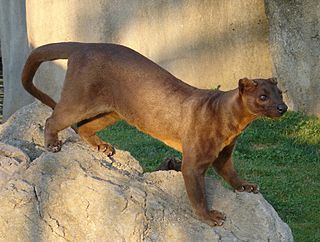
The fossa is a slender, long-tailed, cat-like mammal that is endemic to Madagascar. It is a member of the carnivoran family Eupleridae.

The silvery lutung, also known as the silvered leaf monkey or the silvery langur, is an Old World monkey. It is arboreal, living in coastal, mangrove, and riverine forests in Peninsular Malaysia, Sumatra, Borneo, Java, and other nearby islands.
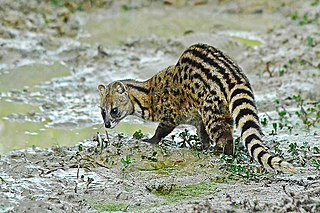
The small Indian civet is a civet native to South and Southeast Asia. It is listed as Least Concern on the IUCN Red List because of its widespread distribution, widespread habitat use and healthy populations living in agricultural and secondary landscapes of many range states.

The banded palm civet, also called the banded civet, is a viverrid native to Indomalaya. They primarily inhabit lowland conifer habitat, which is under threat from encroaching human activity. It is estimated the population of the banded palm civet has decreased by around 30% in just three generations. Banded palm civets are usually approximately the size of a domestic cat; their fur is pale but with dark bands on the back. They are believed to be closely related to Hose's palm civets, which are similar in appearance and distribution.

The masked palm civet, also called the gem-faced civet or Himalayan palm civet, is a viverrid species native to the Indian subcontinent and Southeast Asia. It has been listed as least concern on the IUCN Red List since 2008 as it occurs in many protected areas, is tolerant to some degree of habitat modification, and widely distributed with presumed large populations that are unlikely to be declining.

The brown palm civet, also called the Jerdon's palm civet, is a viverrid endemic to the Western Ghats of India.

The Malayan civet, also known as the Malay civet and Oriental civet, is a viverrid native to the Malay Peninsula and the islands of Sumatra, Bangka, Borneo, the Riau Archipelago, and the Philippines. It is listed as "Least Concern" by IUCN as it is a relatively widely distributed, appears to be tolerant of degraded habitats, and occurs in a number of protected areas.

The large Indian civet is a viverrid native to South and Southeast Asia. It is listed as Least Concern on the IUCN Red List. The global population is thought to be decreasing due to hunting and trapping driven by the demand for bushmeat.
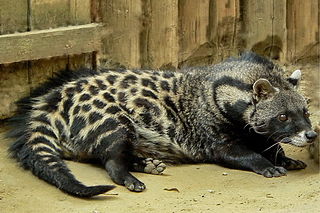
A civet is a small, lean, mostly nocturnal mammal native to tropical Asia and Africa, especially the tropical forests. The term civet applies to over a dozen different species, mostly from the family Viverridae. Most of the species's diversity is found in southeast Asia. Civets do not form a monophyletic group, as they consist only of certain members of the Viverridae, Eupleridae, and Nandiniidae.

Feliformia is a suborder within the order Carnivora consisting of "cat-like" carnivorans, including cats, hyenas, mongooses, viverrids, and related taxa. Feliformia stands in contrast to the other suborder of Carnivora, Caniformia.

The grizzled tree-kangaroo is a furry, long-tailed mammal native to tropical rainforests on the island of New Guinea. Like most tree-kangaroos, it lives in trees and eats leaves, fruit, and bark. It is a member of the macropod family Macropodidae and carries its young in a pouch like other marsupials. The tree-kangaroo is uncommon and threatened by hunting and habitat loss. It is found in foothill forests of northern and western New Guinea and is indigenous to some of the offshore islands.
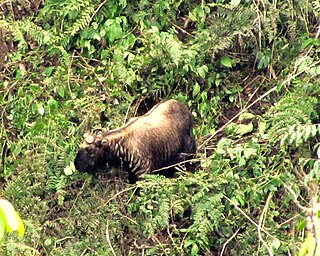
The Bhutan Takin is a subspecies of Takin native to Bhutan but also found in North Eastern India, Western part of China, and Tibet. Locally known as drong gimtse, it holds the honor of being Bhutan's national animal.

The binturong, also known as the bearcat, is a viverrid native to South and Southeast Asia. It is uncommon in much of its range, and has been assessed as Vulnerable on the IUCN Red List because of a declining population. It is estimated to have declined at least 30% since the mid-1980s. The binturong is the only species in the genus Arctictis.
The Afi Mountain Wildlife Sanctuary in Cross River State in southern Nigeria covers 104 km2 (40 sq mi). The wildlife sanctuary was founded in 2000 to provide refuge for endangered animal species, including the Cross River gorilla, the Nigeria-Cameroon chimpanzee, the drill and the gray-necked rockfowl.
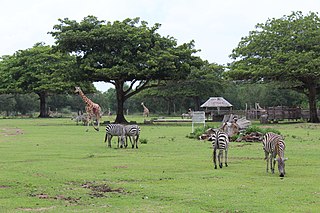
Calauit Safari Park is a wildlife sanctuary in the Philippines which was originally created in 1976 as a game reserve featuring large African mammals, translocated there under the orders of the President Ferdinand Marcos during his 21-year rule of the country.



















